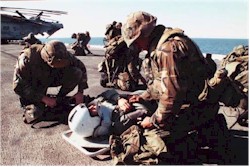|
This video was produced by the US
Navy to assist in instructing medical providers on the medical
management of shock.
It is focused on the immediate
(primary) and secondary care of these patients, as practiced by Navy
Hospital Corpsmen, Medics, or Emergency Medical Technicians.
The video may be freely
downloaded.
|

Exsanguination is the single most common cause of
death on the battlefield; therefore the prevention of exsanguination
at or near the point of wounding must be the single most important
medical task. No hospital, no matter how advanced, and no surgeon, no
matter how skilled, can save a wounded patient who has exsanguinated.
Thus it is true, as Dr. Nicholas Senn, founder of the Associa-tion of
Military Surgeons of the United States, once said, "The fate of the
wounded lies in the hands of the ones who apply the first dressing."
Most of those who die on the battlefield do so within minutes of
wounding. Few of these patients with rapidly exsanguinating wounds can
be saved regardless of the level of care provided; most would die even
if they were wounded right out-side a Level I trauma center. As noted
by Col. Gray during World War I, "The haemorrhage that takes place
when a main artery is divided is usually so rapid and so copious that
the wounded man dies before help can reach him."
Furthermore, a sizeable number who could have been
saved had care been immediately available die because the
circumstances of combat preclude the rapid delivery of such care. An
analysis of 98 Vietnam casualties who died from exsanguination
revealed that nearly 20% had sustained injuries that, in ideal
circumstances, could have been controlled with a tourniquet and/or
appropriately applied direct pressure.5-7 But some casualties with
potentially lethal hemorrhage can be saved and it is upon this group
the combat medical provider must focus.
Immediate Care of the Wounded
Clifford C. Cloonan, MD, FACEP
COL (ret) U.S. Army
|

